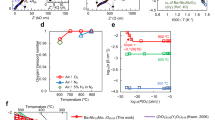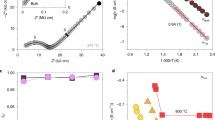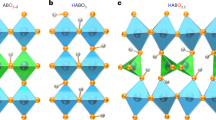Abstract
The need for greater energy efficiency has garnered increasing support for the use of fuel-cell technology, a prime example being the solid-oxide fuel cell1,2. A crucial requirement for such devices is a good ionic (O2− or H+) conductor as the electrolyte3,4. Traditionally, fluorite- and perovskite-type oxides have been targeted3,4,5,6, although there is growing interest in alternative structure types for intermediate-temperature (400–700 ∘C) solid-oxide fuel cells. In particular, structures containing tetrahedral moieties, such as La1−xCaxMO4−x/2(M=Ta,Nb,P) (refs 7,8), La1−xBa1+xGaO4−x/2 (refs 9,10) and La9.33+xSi6O26+3x/2 (ref. 11), have been attracting considerable attention recently. However, an atomic-scale understanding of the conduction mechanisms in these systems is still lacking; such mechanistic detail is important for developing strategies for optimizing the conductivity, as well as identifying next-generation materials. In this context, we report a combined experimental and computational modelling study of the La1−xBa1+xGaO4−x/2 system, which exhibits both proton and oxide-ion conduction9,10. Here we show that oxide-ion conduction proceeds via a cooperative ‘cog-wheel’-type process involving the breaking and re-forming of Ga2O7 units, whereas the rate-limiting step for proton conduction is intra-tetrahedron proton transfer. Both mechanisms are unusual for ceramic oxide materials, and similar cooperative processes may be important in related systems containing tetrahedral moieties.
This is a preview of subscription content, access via your institution
Access options
Subscribe to this journal
Receive 12 print issues and online access
$259.00 per year
only $21.58 per issue
Buy this article
- Purchase on Springer Link
- Instant access to full article PDF
Prices may be subject to local taxes which are calculated during checkout





Similar content being viewed by others
References
Steele, B. C. H. & Heinzel, A. Materials for fuel-cell technologies. Nature 414, 345–352 (2001).
Atkinson, A. et al. Advanced anodes for high-temperature fuel cells. Nature Mater. 3, 17–27 (2004).
Goodenough, J. B. Oxide-ion electrolytes. Annu. Rev. Mater. Res. 33, 9 (2003).
Norby, T. & Larring, Y. Concentration and transport of protons in oxides. Curr. Opin. Solid State Mater. Sci. 2, 593–599 (1997).
Kreuer, K. D. Proton-conducting oxides. Annu. Rev. Mater. Res. 33, 333–359 (2003).
Iwahara, H. Proton conducting ceramics and their applications. Solid State Ion. 86–88, 9–15 (1996).
Haugsrud, R. & Norby, T. Proton conduction in rare-earth ortho-niobates and ortho-tantalates. Nature Mater. 5, 193–196 (2006).
Kitamura, N., Amezawa, K. & Tomii, Y. Electrical conduction properties of Sr-doped LaPO4 and CePO4 under oxidizing and reducing conditions. J. Electrochem. Soc. 152, A658–A663 (2005).
Li, S., Schönberger, F. & Slater, P. La1−xBa1+xGaO4−x/2: a novel high temperature proton conductor. Chem. Comm. 21, 2694–2695 (2003).
Schönberger, F., Kendrick, E., Islam, M. S. & Slater, P. Investigation of proton conduction in La1−xBa1+xGaO4−x/2 and La1−xSr2+xGaO5−x/2 . Solid State Ion. 176, 2951–2953 (2005).
Kendrick, E., Islam, M. S. & Slater, P. R. Developing apatites for solid oxide fuel cells: Insight into structural, transport and doping properties. J. Mater. Chem. 17, 3104–3111 (2007).
Kilner, J. A. Optimisation of oxygen ion transport in materials for ceramic membrane devices. Faraday Discuss. 134, 9–15 (2007).
Haile, S. M., Boysen, D. A., Chisholm, C. R. I. & Merle, R. B. Solid acids as fuel cell electrolytes. Nature 410, 910–913 (2001).
Larson, A. C. & Von Dreele, R. B. “General Structure Analysis System (GSAS)”, Los Alamos National Laboratory Report LAUR 86–748 (1994) Toby, B. H. EXPGUI, a graphical user interface for GSAS. J. Appl. Cryst. 34, 210–213 (2001).
Gale, J. D. & Rohl, A. L. The general utility lattice program. Mol. Simul. 29, 291–341 (2003).
Catlow, C. R. A. (ed.) Computer Modelling in Inorganic Crystallography (Academic, San Diego, 1997).
Refson, K. Moldy: a portable molecular dynamics simulation program for serial and parallel computers. Comput. Phys. Commun. 126, 309–328 (2000).
Baroni, S. et al. <http://www.pwscf.org/>.
Vanderbilt, D. Soft self-consistent pseudopotentials in a generalized eigenvalue formalism. Phys. Rev. B 41, 7892–7895 (1990).
Burke, K., Perdew, J. P. & Wang, Y. in Electronic Density Functional Theory: Recent Progress and New Directions (eds Dobson, J. F., Vignale, G. & Das, M. P.) (Plenum, New York, 1998).
Perdew, J. P. et al. Atoms, molecules, solids, and surfaces: Applications of the generalized gradient approximation for exchange and correlation. Phys. Rev. B 46, 6671–6687 (1992).
Monkhorst, H. J. & Pack, J. D. Special points for Brillouin-zone integrations. Phys. Rev. B 13, 5188–5192 (1976).
Islam, M. S. Ionic transport in ABO3 perovskite oxides: a computer modelling tour. J. Mater. Chem. 10, 1027–1038 (2000).
Minervini, L., Grimes, R. W. & Sickafus, K. E. Disorder in pyrochlore oxides. J. Am. Ceram. Soc. 83, 1873–1878 (2000).
Sayle, T. X. T., Parker, S. C. & Sayle, D. C. Oxygen transport in unreduced, reduced and Rh(III)-doped CeO2 crystals. Faraday Discuss. 134, 377–397 (2007).
Acknowledgements
This work was supported by the EPSRC (Project grant: GR/S55507/02). We would also like to thank ISIS, Rutherford Appleton Laboratory UK for access to neutron diffraction facilities.
Author information
Authors and Affiliations
Corresponding authors
Supplementary information
Supplementary Information
Supplementary tables 1-2 and figures 1-6 (PDF 1489 kb)
Rights and permissions
About this article
Cite this article
Kendrick, E., Kendrick, J., Knight, K. et al. Cooperative mechanisms of fast-ion conduction in gallium-based oxides with tetrahedral moieties. Nature Mater 6, 871–875 (2007). https://doi.org/10.1038/nmat2039
Received:
Accepted:
Published:
Issue Date:
DOI: https://doi.org/10.1038/nmat2039
This article is cited by
-
A Molecular-Sieving Interphase Towards Low-Concentrated Aqueous Sodium-Ion Batteries
Nano-Micro Letters (2024)
-
In situ electrochemical Raman spectroscopy and ab initio molecular dynamics study of interfacial water on a single-crystal surface
Nature Protocols (2023)
-
Enhanced oxygen evolution over dual corner-shared cobalt tetrahedra
Nature Communications (2022)
-
In situ Raman spectroscopy reveals the structure and dissociation of interfacial water
Nature (2021)
-
Energy landscapes of perfect and defective solids: from structure prediction to ion conduction
Theoretical Chemistry Accounts (2021)



